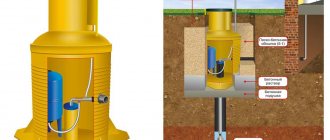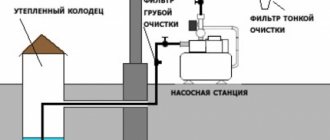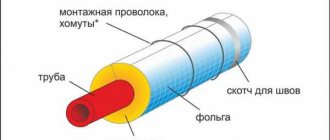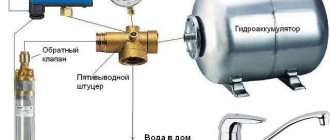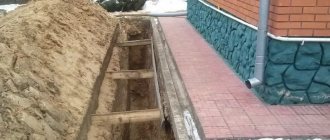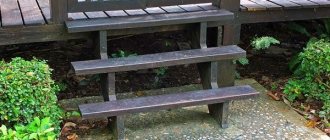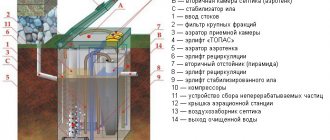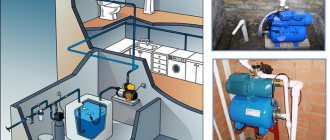Collecting water from wells and wells dug on your property or beyond its boundaries is the only option for obtaining water in housing not connected to a centralized water main. Although permanent water supply to a private home from a well is not as popular as well, in some cases it is more suitable for homeowners.
There are several methods for providing water to residential buildings from well sources. Each of them deserves attention and is the most preferable depending on the technical capabilities of the structures, the number of residents and the frequency of their stay.
Rice. 1 Well diagrams
Features of well water supply
Typically, a country house well on land is dug to a depth of up to the first aquifer, and most sources have the following operational and technical characteristics:
- Wells are dug manually and mechanized using heavy equipment using large drills or crowns. The depth of well shafts varies from 5 to 35 m. They can reach not only the first, but also the second or even third aquifers.
- Due to the shallow depth, the pressure of the soil mass on aquifers is not as great as in wells. Therefore, the flow rate of wells is not so high (rarely above 1 cubic meter per hour) and is capable of providing water supply with long interruptions or for a limited number of residents (usually no more than 1 person).
- The use of electric pumps in wells often leads to the lifting of silt deposits and small sand particles from the bottom. Therefore, coarse and fine sand filters must be installed in the water supply main.
- The first aquifer is susceptible to contamination by surface and groundwater, so the quality of well water in densely populated areas is low. To avoid contamination, it is recommended to locate wells at a greater distance from environmentally hazardous objects than wells.
- To protect against silting, wells need periodic cleaning once or twice a year.
- The water surface in wells is subject to seasonal changes; in the hot season, the water level can drop significantly.
- Unlike water wells with water intake only using pumping equipment, wells can be used in the absence of electricity.
- In areas with a cold climate, in sources with high water levels, measures must be taken to insulate them.
Rice. 2 Types of wells
Types of water supply
If the central system is unavailable, autonomous water supply can be realized using a deep artesian well (a rather expensive structure that requires professional execution and the use of special equipment), a shallower sand well or a surface driven well, which is called an “Abyssinian” or “needle”. Whether the water supply scheme for a private house from a well has significant advantages when compared with these options, we will consider below, comparing the operating features, pros and cons.
What materials are wells made of?
Usually, after excavation work, a column of various types of building materials is installed in a well shaft, after which crushed stone and sand are poured into the bottom to filter and purify the water from clay impurities.
The traditional material for installing wells is reinforced concrete rings of various diameters and heights. The most suitable for installation are their varieties with an internal diameter of 1000 mm and a height of 890 mm (according to GOST 8020-90) with a lock. To ensure high strength characteristics, they are made from heavy concrete, which is used to fill the reinforcement.
To seal the shaft, many use concrete slabs with a hatch, which is covered with a light polymer lid.
The main advantages of concrete rings are low cost, long service life, reliability and strength.
More modern columns for shallow wells are sections of double-layer corrugated pipes of large diameters (Korsis, Pragma), the main material of which is low-density polyethylene (HDPE). They are much easier and faster to install, but the high price of corrugated pipes hinders their widespread use.
One of the main areas of application of polymer pipelines is the restoration (renovation) of partially destroyed concrete and contaminated well shafts.
In the retail chain you can find polymer sand rings produced by some commercial companies. They have an internal diameter of 960 mm, a height of approximately 200 mm and a wall thickness of 40 mm. They can be used to assemble a prefabricated shaft of almost any height. However, these products, due to their high price and insufficiently reliable sealing between the ring fragments, are not widely used in everyday life.
Other exotic and labor-intensive options for constructing domestic wells - laying out a shaft from a log frame, brick, building blocks, filling it with concrete - due to their impracticality, have not found application in everyday life.
Related article:
What kind of sewer rings are used in individual construction. This article discusses in detail the types of existing well rings and how concrete and plastic wells are installed.
Rice. 3 Water supply to a private house from a well with a storage tank
Self-installation of water supply in the country
It is quite possible to install a country water supply system from polyethylene pipes with your own hands. You just need to choose the appropriate wiring diagram and select the components.
Source of water supply
First of all, pay attention to where the power will come from. It is from the source that they start when drawing up a project
It could be:
- city or village network;
- well or well;
- river or pond;
- autonomous water tank.
Connection to the central water supply is made using a patch tee with bolting at the entry point.
Water from a natural reservoir is usually used for watering the garden - it is not clean enough for drinking.
Clean water lies very low in the soil layers and is extracted from an artesian well through deep drilling. The sand analogue is no different in depth; you will need to install filters to remove impurities. The same applies to a country well. In all these cases, the pump will need to be connected via a check valve and specialized fittings.
Water supply to a private house from a well - options
To organize an autonomous water supply from a well, you will need electric pumping equipment for water intake. It is neither practical nor very reasonable to use mechanisms in the form of hand pumps and other devices due to the fact that the simplest vibration pump can be purchased on the market for only 20 USD.
Other equipment is also relatively inexpensive, for example, the initial cost of a pumping station with a hydraulic accumulator, relay and pressure gauge starts from 100 USD.
Also, the owner will have to lay external and internal water supply from various types of pipes; if polymers are used, their cost is also relatively low.
Systems with storage capacity
Given the relatively low flow rate of the well, the possibilities of continuously pumping water out of it are limited. Therefore, the use of storage tanks, where injection occurs periodically in small volumes, is best suited for shallow wells with low pressure.
The storage water supply system for a private house from a well includes an electric pump and a tank with a volume of about 200 liters on the top floor or attic, connected to each other by a pipeline. An in-house water supply system departs from the reservoir, directing water to the distribution points.
The system with a storage tank works according to the following principle. An electric pump immersed in a water supply well (usually an inexpensive vibration pump) when turned on begins to supply water to a container in the attic. A float switch is installed in the tank, connected in series to the pump power cable. As soon as the tank is filled with water, the float rises, the contacts of the pump's power circuit open, and it stops pumping.
Rice. 4 Water supply to a private house from a well with a tank and a pressure-boosting station
When water is consumed, the reserves collected in the tank are consumed, the water level drops and the float switch lowers. The contacts inside it close the power supply circuit of the pump, it turns on and starts pumping water again.
If the design of the house does not allow installing a storage tank at the top of the attic, you can lower the tank down or bury it underground. In this case, to supply water to the internal water supply, you will need an additional surface electric pump or station.
There is an option to install a storage tank below, in which you can do without an additional electric pump. However, in this case, you will have to purchase an expensive large-volume hydraulic accumulator and pump water into it with a pump through a pressure switch, which will turn off the water supply when a given pressure threshold is reached.
The disadvantages of the scheme with a storage tank include the rather low pressure in the system, the standard indicator for individual houses is in the range from 1.5 to 2 bar.
A system with a storage tank can only provide a pressure of about 1 bar when the height of the tank is 10 m above the level of water intake points. However, there is a way out of the current situation, and it consists of installing an additional booster electric pump into the water main.
Installation of a water supply system
Several useful general rules will help you properly arrange the water supply for your dacha or cottage from a well:
- it is necessary to correlate the performance of the pump and the hydraulic exchange rate of the well so that the pumping equipment does not run idle if the water in the well does not have time to accumulate;
- as a protective measure, the pump should be equipped with an automatic unit that will shut down the equipment if water stops flowing into the system;
- when sealing the entrance of a water pipe into the wall of a well, it is recommended to pay special attention to the reliability of the seal, using multi-layer insulation, which includes not only cement mortar, but also a layer of silicone and liquid glass;
- so that in the event of equipment failure, water does not flow out of the system back into the well, a special check valve should be installed;
- in addition to the mesh filter at the end of the water pipe lowered into the well, it is recommended to use an additional mechanical cleaning filter, which is installed after the pump;
- filters should be selected and placed in such a way that it is easy to maintain them, in particular, replace cartridges;
- In case of an accident, it is imperative to install a drain valve, which will completely remove water from the system if the equipment suddenly breaks down.
The easiest way to install a system is with a storage tank and a manually controlled pump. When installing and connecting the pumping station, you should carefully study the manufacturer’s recommendations and follow them exactly.
Stage #1 - install the pump and storage tank
The process of installing a system with a storage tank is relatively simple. It is necessary to install a tank; for this, a container made of stainless steel or plastic is usually used. The more water it holds, the better, but remember that this creates additional load on the floors and foundation.
To correlate the load-bearing capacity of building structures with the increased load, engineering calculations may be necessary. As mentioned earlier, it is recommended to insulate the tank.
The storage tank can have different volumes and configurations. If the container is installed in an unheated room, it must be insulated
The second important element of this system is the pump. If water is drawn from a depth of less than 9 meters, a surface self-priming pump can be used. Such models are cheaper and easier to operate, but for them to work correctly you will need an insulated room: basement, utility room, etc.
Sometimes an auxiliary building is placed next to the well. If the depth of water intake exceeds 9 meters, you will need a special deep pump. Both vibration and centrifugal models can be used in wells.
Stage #2 - connect the pumping station
For the pumping station, you can also arrange a utility room near the well or place it directly in the house. If you decide to install it below ground level, you should dig a recess so that all equipment is located below the freezing point of the soil. The chamber for pumping equipment is carefully insulated.
First, a diaphragm hydraulic tank and pump are installed, then a control relay is connected to the system. It is connected to the water supply system using a special adapter tap.
The connection procedure is usually indicated on the cover of the device or in its instructions. The already installed factory settings are not always suitable for a particular situation, so the relay will almost certainly have to be configured in a new way.
The pumping station can be placed directly in the ground. Such a room must be insulated and ensure a temperature of at least +2 degrees Celsius.
For the pumping station, a separate power supply line with an automatic switch for emergency shutdown should be provided. After this, the system is turned on and its operation is checked.
Particular attention should be paid to the junctions of system elements with water pipes in order to immediately eliminate possible leaks.
When installing pumping equipment, it is necessary to provide for the installation of coarse and fine filters, which will protect the mechanisms from contamination and improve water quality
If the installation of an autonomous water supply from your own well is done correctly, it will function successfully for many years. It is only necessary to regularly carry out the necessary maintenance: cleaning the well, replacing filters, checking the settings of the automatic control system, etc.
A skilled craftsman can perform a significant part of all the work on his own, but for complex operations, for example, soldering PVC pipes or connecting electrical systems, it makes sense to invite a specialist.
Pump equipment
To supply water from a well, several types of electric pumps are usually used. The main requirements for them are to ensure working pressure in the main line and the ability to operate with a small amount of suspended particles of sand and silt.
Vibration pumps
Vibration pumps operate on the principle of reciprocating movement of a coil armature, to which a piston that draws in water is connected, when alternating current is supplied to it. The entire electrical part is placed in an aluminum housing, which has a row of water intake holes with a check valve on one side, and an outlet pressure pipe on the opposite side.
A typical vibration pump is capable of supplying water with a maximum head of 72 m and an injection volume of 1.1 m3/hour. The normal mode of operation of the pump is determined by the graph of pressure characteristics, reflecting the dependence of pressure on the supply volume. That is, the actual volume of water supplied by the vibrating pump is at the level of 0.5 m3/hour at a liquid lifting height of 20 - 30 m.
The advantages of vibration pumps primarily include their low cost and unpretentiousness to sand and clay contamination of the working environment.
The most obvious disadvantages of vibration pumps are their low efficiency (about 35%), the lack of built-in protection against overheating in many models, and the harmful effects of vibrations on the walls of the well and the bottom sand layer. If the pump is used for a long time, the soil may become compacted and the source may become silted too quickly.
Also, all models of vibration pumps cannot withstand deep immersion under the water surface; this distance is usually no more than 3 m.
From the characteristics of the pump it is clear that its low volume of water supply is only acceptable for systems with a storage tank.
A number of Chinese and Russian manufacturers are engaged in the production of vibrating pumps; amateur gardeners are well aware of their brands Malysh, Vikhr, Aquarius, Brook, Hammer, Stavr, Unipump, Oasis, Livgidromash.
Rice. 7 Design of a float well electric pump and its connection diagram
Winter water supply
Winter water supply at the dacha can be done in two variations:
- for regular year-round use;
- for periodic use while maintaining the ability to start at any time.
The first option, in principle, is used not only in the country, but in ordinary country houses and cottages. It is assumed that people live there permanently, which means the house is always warm. This eliminates the installation process from installing a conservation system, which provides conditions for complete drainage of water from the pipelines.
Installation of a water supply system with the possibility of conservation is complex and, most often, is carried out by professionals with special skills. This is not surprising, because the conservation system is designed to maintain full functionality of the water supply year-round, even when no one lived in the house for a long time and it was not heated.
Required pipes and fittings
In both the first and second cases, the water supply system involves the implementation of an underground pipeline, the laying of which to the water source is laid at a depth of 1.4-1.8 m. Moreover, we must not forget about maintaining the slope in relation to the water source where the drain tap is installed or solenoid valve. Although, if the length of the pipeline from the water intake point to the house does not exceed 8 m, then it is not necessary to include these devices in the water supply system.
Winter water supply option with well insulation
Water supply pumping stations for summer cottages are very often used. Any such installation operates automatically and with its help you can create a truly autonomous water supply in a suburban area. It is an excellent alternative to a submersible pump and supplies water from underground tanks. The components of the pumping station are a hydraulic accumulator, mesh filters, relays, etc.
Well submersible pumps
The retail chain sells a wide range of special well electric pumps that do not function without cooling in an aquatic environment. Most of them operate on a centrifugal principle, that is, they draw water into the impeller and supply it through the central hole in the housing to the outlet pipe.
The design of centrifugal pumps allows them to be assembled from a number of pressure-increasing stages, each of which has its own impeller. As a result, an arbitrarily high water pressure is obtained at the output.
Most household centrifugal pumps for wells have a maximum pumping volume of about 5 m3/hour and can lift water up to 50 m.
Since the water surface often drops in wells due to low flow rates, all well units are equipped with a float switch to protect against burnout of the electric motor winding.
Usually the submersible pump is suspended in the middle of the shaft in order to leave free space for the float.
The disadvantages of well units include their much higher cost than vibratory pumps.
The advantage is the ability to implement large volumes of pumping, which allows you to provide water to a family of 3-4 people.
Also, centrifugal submersible electric pumps have a higher efficiency of about 60%, do not create harmful vibrations, and are much more reliable and durable in operation compared to low-quality vibration pumps.
It is worth noting that to connect and automate the operation of well electric pumps you will need a pressure and idle switch, a battery tank, and a pressure gauge. These devices are usually placed in the house and less often in a pit, an above-ground building, located near the source.
In the trade you can also find several models of screw pumps for wells (Unipump), which are distinguished by their unpretentiousness when operating in a polluted environment.
All manufacturers of electric pumping equipment from China, Russia and Europe are engaged in the production of deep-well electric pumps. The most famous brands: DAB, Gardena, Speroni, Belamos, Gileks Vodomet, Grundfos, Vodotok, Aquario. The cost of the cheapest models of Russian-Chinese pumps is about 9,000 rubles, for the most expensive DAB it reaches almost 50,000 rubles.
Rice. 8 External and internal structure of the pumping water intake station
Pumping stations
If to connect the submersible well electric pumps discussed above it was necessary to additionally mount a hydraulic relay, a battery tank and a pressure gauge, then in the pumping station the pump and the above-mentioned devices are combined in one block.
The pumping station is located on the surface, while the water surface in the well should not fall lower than 8 - 9 meters from its body.
If the distance is greater, the pressure hose will not be able to draw in water, and the station will remain inoperative.
Taking this into account, stations are often placed next to a well or in a house if the distance between the building and the source is short.
The volume-pressure characteristics of the vast majority of stations correspond to well submersible electric pumps. The maximum pumping volume does not exceed 5 m3/h, the liquid lifting height is no more than 50 m.
The advantages of installing a system with a pumping station include its simplicity. There is no need to lay pipelines and use fittings to connect the hydraulic tank, pressure switch, pressure gauge and electric pump together.
The stations are manufactured by a wide range of Russian, Chinese and European manufacturers, the most famous brands being Gardena, Belamos, Gilex, Denzel, Grundfos, Metabo, Elitech, Marina, Al-Ko, Quattro Elementi, Wilo, DAB.
The peculiarities of all stations are their relatively low price compared to the cost of separately purchased components; a good unit can be bought for 6,000 - 7,000 rubles.
Selecting a water intake source
In rural areas, drinking water can be obtained from a public main, a well or a borehole. The first option is extremely rarely available, so summer residents equip their own source.
water well
A well is the best option for supplying a country house with water. The construction is more expensive than a well, but the flow rate is much greater and the water quality is higher. They hire drillers with equipment or do it themselves using homemade devices.
Water supply from a well
Most sites have a well. Its depth varies, depending on the location of groundwater. If it does not exceed 15 m, they dig a well: construction is cheaper than drilling a well. The flow rate does not exceed 200 liters; there is a risk that the water will be contaminated with nitrates, bacteria, and heavy metals. You will need to arrange high-quality filtration.
The well is easy to maintain and is maintained in good condition without significant costs. The main disadvantage is that the source cannot always provide the required volume of water. 200 l/h is an indicator of the best well; more often it turns out to be less. It is necessary to calculate how much water is needed and whether the source can provide such a volume.
Water supply from a well.
External and internal water supply
To supply water from a well to a house, pipes are laid underground, and there is no alternative to pipelines made of low-density polyethylene (HDPE).
Black HDPE pipes for water supply are made from virgin polyethylene and have a blue stripe on the side shell. Their size is determined by the outer diameter, the most popular of which are 25 and 32 (by 1 and 1 1/4 inches).
HDPE pipeline connections are made using compression fittings made of the same polymer material. Modern fittings have a wide selection of adapter couplings, bends, and tees. They have standard pipe threads that fit perfectly with steel ones.
The fastest, most economical, reliable and durable option for laying internal water supply in a private home is the use of polypropylene pipes.
The main difficulty is their soldering, the high-quality implementation of which can be done by specialists with extensive experience. You can save significant financial resources by mastering this simple procedure yourself. A soldering iron at a price of 3,000 rubles will cover the cost of doing the work yourself and is quite suitable for small amounts of soldering.
Choosing other materials for laying the internal pipeline, for example, metals such as copper and stainless steel, will lead to a significant increase in cost and impracticality of the water supply system. These materials are used mainly for laying heating lines.
And other types of polymer pipes, mainly cross-linked and reinforced polyethylene (metal-plastic), are more expensive to install due to the high cost of compression fittings and the need to use special tools.
Related article:
Soldering iron for polypropylene pipes - types, features, prices. A separate article describes the types of soldering irons, methods of soldering pipes, and price categories.
Rice. 10 Use of vibration pumps in wells
Source requirements
When drawing up a water supply scheme, be it water supply in a country house or installation of a system in a private house, we must not forget about SNiP. Here are a few technical specifications to follow:
- The mine must be deep. At least four to five reinforced concrete rings.
- The material from which the well is assembled must be reliable and durable. A reinforced concrete ring with a diameter of 1.5–2.0 meters, with a groove assembly system, is best suited. Instead, you can use reinforced concrete pipes with a diameter of at least 800 cm, installed vertically with the socket up.
- An optional requirement is external sealing of the rings with a HDPE sheet. The new advanced technology will be a barrier to silt and clay, which in any case will penetrate inside. Here you should remember that you still have to make holes in the ring, otherwise the source will simply dry out.
- When installing a source, be sure to pour 20–30 cm of sand and gravel mixture onto its very bottom, and preferably screenings with coarse stones.
- After installing the well, it is completely filled with screenings or ASG. Since water must penetrate into the shaft, it cannot be made too airtight.
- The final requirement would be an absolute ban on the use of metal. Over time, it will begin to oxidize and rust, and no filter will help here.
Advice: when using the source year-round, its upper part should be insulated, especially the head.
Installation of a water supply system from a well
When installing an autonomous water supply system from a well, the following nuances must be taken into account.
An external HDPE pipe from a well source is laid underground. In this case, it will not interfere with the area and will not suffer from drying out and cracking under the influence of ultraviolet radiation.
If you plan to supply your home with year-round water, you will have to take care to protect the underground pipeline from freezing.
There are two options here. The first is to lay a water supply system in the ground below the freezing level of the soil, in the middle zone this is approximately 1 - 1.5 m.
The second option is to place a special self-heating electrical cable inside the HDPE pipe. To implement this method, cables are sold in retail chains complete with tee adapters for insertion into the pipeline.
Some users believe that insulating an underground pipeline will prevent it from freezing in winter, and therefore the depth of its installation can be reduced to 300 - 500 mm. However, this is not true - insulation only increases the time required for pipes to freeze and, during prolonged frosts, will not protect against ice formation.
Another nuance of all the work is the size of the well. Since the pipeline will have to be installed inside, the width of the rings must be sufficient to accommodate one worker in the shaft.
Rice. 11 Water supply diagram with a submersible electric pump
Installation of a submersible electric pump in a well
To place a submersible electric pump in a well shaft, the following operations are carried out:
- First, a trench is dug from the house to the well. To drain water from the internal water supply to the source, provide a slope towards the well of the order of 10 - 30 mm per linear meter. According to GOST it should be 30 mm, but in this case it does not play a big role.
- Near the well, a small expansion of the trench is made for ease of work and a through hole is punched in the concrete wall, using a hammer drill for this purpose.
- A HDPE pipe and an electrical power cable placed in an insulating corrugated pipe are laid in the trench, their ends are led out into the well through a hole.
- Prepare the electric pump for immersion by connecting a section of HDPE pressure hose to it and tying a cable. Then the pressure hose, cable and electrical cable are connected together with plastic ties.
- A folding ladder is placed in the well, one of the workers climbs inside and lowers the pump to the bottom. Then he raises it by 400 - 500 mm and puts a mark on the HDPE pipe opposite the entrance of the water main going into the house.
- The HDPE pressure pipe is cut at the level of the mark and then the installation of a support stand for hanging the pump begins. To do this, use a special metal corner bracket with holes.
Rice. 12 Installation of a submersible pump in a well - main steps
- Place the bracket against the inner walls of the well, make marks, and then make holes with a drill of a suitable diameter using a hammer drill.
- The support post is secured, fixing it by driving in special anchors with a hex head, the bolts of which are then tightened with a wrench.
- Screw the HDPE pressure pipe of the pump to the pipeline going into the house using an elbow compression fitting.
- Then hang the pump on a cable to the bracket, connect its power cord through heat-shrinkable sleeves to the electrical cable extending from the house.
At this point, the installation of the submersible pump can be considered complete.
But often the piping layout inside the well is complicated.
A through hole is made at the top of the concrete ring and a pipeline with a tap for watering the garden is fixed in it. Its pipe section is connected to the pressure hose.
Also, a tee with a side tap is mounted on the horizontal section of the pressure hose. It is necessary to drain water from the system.
To rotate the lever of the ball drain and water supply valve for irrigation, long rods soldered from polypropylene are used, the handles of which are brought closer to the edge of the well and fixed on its walls with clamps.
Rice. 13 Connection diagram for a pumping station for water supply to a private house from a well
Installation stages
Do-it-yourself installation of a water supply system for a country house based on a well is carried out in a certain sequence.
- Calculations and development of a scheme for supplying water to the house and distributing it to water points, creating sketches that will simplify installation.
- Development of a power supply diagram.
- Connecting the pipeline to the house.
- Installation of filters.
Important: Pumping equipment for water supply in a country house is installed and connected when work inside the house is completed - installation of pipes, connection of plumbing and household appliances, etc.
The final stage is connecting the pumps to the pipelines, power supply and control system.
Advantages and disadvantages of water supply from a well
There are two main disadvantages of a well as a source:
- Dependence of flow rate (maximum volume of water dispensed per unit of time) on season:
- significant impact on water quality from environmental conditions of both the region and the surrounding area.
This distinguishes a well from wells, especially artesian ones, that reach deep aquifers, where the yield and quality of water is stable. Unfortunately, the disadvantages of a mine well cannot be eliminated. After all, they are directly related to the principles of its functioning. The wells are fed by groundwater, the reserves of which are replenished by precipitation and nearby bodies of water. Therefore, despite some natural ground filtration and purification, harmful substances from the atmosphere and waste discharged into rivers inevitably enter well water.
The flow rate of a well is significantly affected by seasonal fluctuations in groundwater levels. For example, if the spring water level is almost level with the ground, by August the mine water intake may dry out completely.
Why, despite the significant disadvantages indicated, do well structures still remain popular? It's simple. Firstly, they are particularly simple in design and maintenance compared to deep wells. Secondly, the quality of water from them is still an order of magnitude better than from open water intakes (rivers, lakes, ponds).
It should also be taken into account that the scheme for supplying water from a well to the house is more economical compared to centralized water supply. At today's prices for water, even if the quality does not allow it to be used other than technical water, an autonomous source pays for itself in several years.
Selection of a pumping station for a well
In addition to submersible pumps, we install pumping stations. A vacuum is created in them, and the water rises due to the pressure difference. The station can lift water from a depth of up to 7-8 meters, while the distance from the house should be no more than 30-40 m. Otherwise, the pressure will not be enough to lift water from the well.
The pumping stations we install are Belamos and Grundfos MQ.
Belamos - surface pumps assembled with a hydraulic accumulator and pressure switch. There is an auto shut-off function when overheating. They can lift water from a depth of up to 8 m.
Models of Belamos pumping stations
Pressure characteristics of Belamos pumping stations
Grundfos MQ
– pumping stations with built-in automation - pressure switch, dry-running protection relay, hydraulic accumulator. There is a built-in check valve. The maximum suction depth is 8 m. The advantage of this pump is its low noise level. The built-in hydraulic accumulator has a small volume, so it is recommended to install a separate hydraulic tank of the required volume.
Grundfos MQ suction stations are available in 2 models:
- Grundfos MQ-3-35 with a capacity of 3 m³/h and a head of 35 m.
- Grundfos MQ-3-45 with a capacity of 3 m³/h and a head of 45 m.
Pressure characteristics of Grundfos MQ pumping stations
Water treatment equipment
You should not think that water from a well will be absolutely clean. For example, if your neighbors have a cesspool or a septic tank installed, then their wastewater will pollute your area. In addition, industrial waste can also enter the soil. Natural filtration in the soil makes underground water cleaner, but it is not enough. For high-quality cleaning, special filters are needed.
Modern water treatment systems allow:
- Remove chlorine from water;
- Remove harmful organic compounds;
- Remove manganese and iron;
- Reduce the concentration of calcium and magnesium;
- Disinfect water.
What types of filters are there for water treatment?
- Aeration filters for iron oxidation and precipitation
- Devices with filter media for sedimentation of large particles, sand and rust;
- Activated carbon filters for removing chlorine and gases contained in water;
- Ion exchange filters to reduce water hardness;
- Filters with PH correctors to normalize the acid-base balance.
Before selecting equipment, you need to take water from the well for analysis. This will be done by our company’s specialists. The analysis is performed in a laboratory and takes several days.
The chemical composition of water varies depending on the time of year and natural conditions. Sometimes stable water quality cannot be achieved, so filters are selected with some reserve.
Recommended products
We recommend
Water purification system from well No. 1 - Iron Manganese Ammonium Hardness Color
Availability: yes
RUB 36,200
Water purification system from well No. 2 - Iron Manganese Turbidity Odor of hydrogen sulfide
Availability: yes
RUB 34,700
Water purification system from well No. 3 - Iron Manganese Hardness
Availability: yes
RUB 30,090
Water purification system from well No. 4 - Iron Manganese Ammonium Hardness Color Turbidity
Availability: yes
RUB 53,500
Water purification system from well No. 5 - removal of excess iron, manganese, color, turbidity, odor
Availability: yes
48,000 rub.
Water purification system from well No. 6 - removal of excess iron, manganese, ammonia and water softening
Availability: yes
RUB 111,937
Diagram of a device with a hydraulic accumulator and pumping station
The automatic mode of supplying water to the house from a well is based on the operation of a pump. A better option, although more expensive, are pumping stations.
Although a pumping station costs more than a regular pump, its cost determines its functionality. The station includes the following elements:
- electric pump
- hydraulic accumulator
- connecting fittings
- pressure gauge
- pressure switch
As a rule, stations are also equipped with an internal filter that can remove all excess when pumping water through the main line.
One of the most important elements in the pumping system is the hydraulic accumulator. It is he who regulates the required level of pressure and ensures that the pump tubes and other elements do not wear out quickly. Due to the operation of the battery, even in the absence of electricity, you can have a supply of water for some time.
The main positive properties of the battery are as follows:
- Extending the life of the pump. Any pump has a clearly defined number of starts per hour. The hydraulic accumulator does not allow the pump to turn on when the tank is full. This means that the pump does not have to turn on every time. The supply of inclusions will increase and the pump will last longer.
- Pressure adjustment. Due to the increase/decrease in pressure, the user encounters such troubles as temperature changes. It is the hydraulic accumulator that is designed to keep the pressure at the same level.
- Mitigation of water hammer that can damage pipes.
- Additional water supply during power outages.
The positive aspects of the presence of a hydraulic accumulator in the pumping station are in favor of its use. Of course, you can do without this element. However, those who approach the issue of organizing water supply decisively still purchase a hydraulic accumulator.
Unlike the use of pumps, with a pumping station the consumer can always be sure that the required volume of water will be provided at any time in the right quantity from the well to his own home.
Battle of psychics - how to find a place for a well?
The prospect of acquiring an autonomous water supply at their dacha motivates even those homeowners who are connected to the central water supply to dig a well. It's simple - having an almost unlimited supply of resources, you can organize high-quality watering of garden and vegetable plants without fear of huge bills for consumed water. In addition, in many villages the water supply system was laid during the Soviet Union, and constant unscheduled repairs turn the central water supply into a central water shortage.
Autonomous water supply from a well
Why a well and not a borehole? Because it is much cheaper, more durable and does not require official permits from government agencies. You can dig a well at your dacha yourself if you have sufficient free time and desire. However, even hired workers will cost less than renting equipment for drilling a well.
What will need to be done is clear, but what about choosing a location for the well? You can test your own or your neighbors’ psychic abilities, but it’s better to use nature’s clues.
Choosing a location for a well
- The first method is to measure the water absorption of red clay bricks. The bricks for the experiment should be as dry as possible. Weigh each one carefully, write down the data, number them and bury them half a meter deep in the places where you would like to dig a well. After a day, dig up the bricks and weigh them again. The heaviest brick will indicate the closest location of the aquifer.
- The second method is to observe the surrounding landscape and the behavior of animals in the country. Some dog breeders have noticed that their pupils prefer the same places in the countryside to all others in the summer heat. This is explained by the fact that there is an aquifer close to the surface, which makes the ground cooler. Keep an eye on the plants on your site - coltsfoot, sedge, alder, and birch will never choose dry soil to grow; they take root only where there is water close to the surface. Also watch for the appearance of fog in the countryside - fog will form over the place where there is a lot of water.
- The third and most accurate method is exploration drilling. Even an ordinary garden auger, homemade or purchased, with an extendable handle, is suitable for this method. Sometimes a few meters are enough to understand that there is an aquifer underneath.
Exploration, as well as the main work on arranging a well, should be carried out in the summer months, when it is hot - at this time, spring groundwater will no longer interfere with work and will not mislead. You can dig a truly inexhaustible well at your dacha that will not dry out even in summer.
